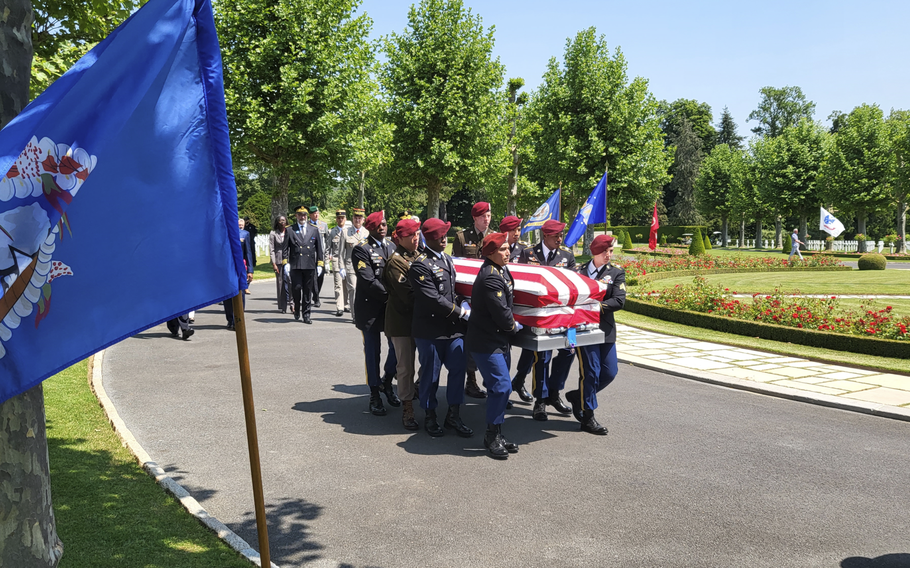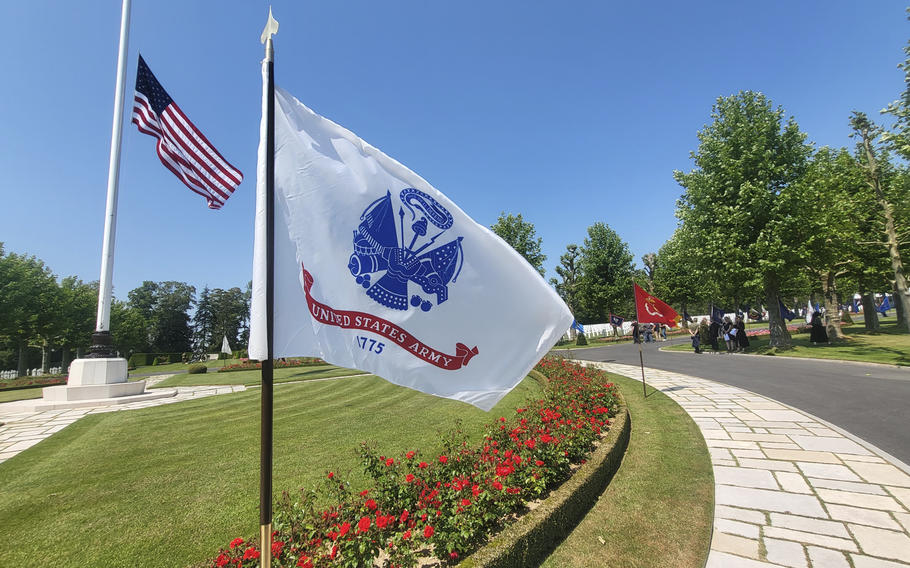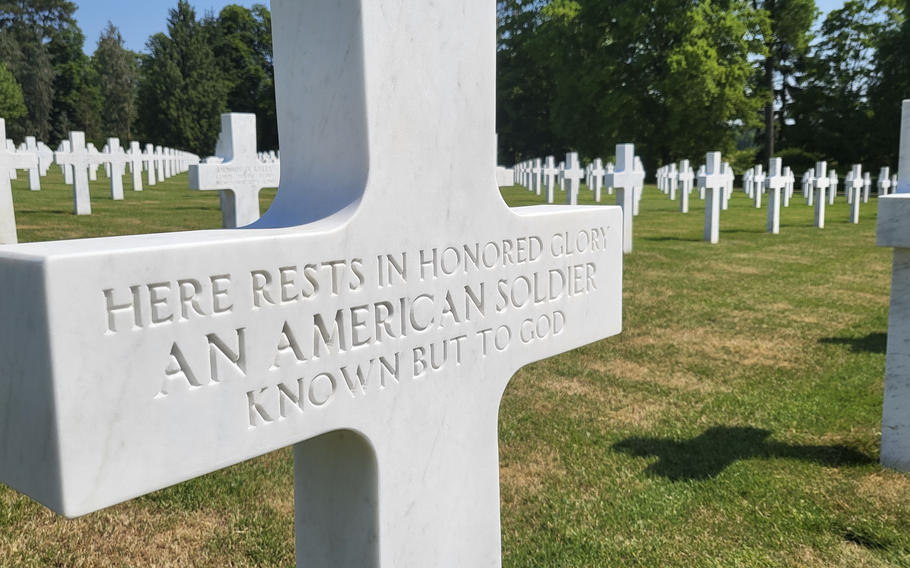
Military casket bearers carry the remains of an unknown American soldier from World War I to his final grave site at Oise-Aisne American Cemetery in Seringes-et-Nesles, France, on Wednesday, June 7, 2023. (Doug G. Ware/Stars and Stripes)
SERINGES-ET-NESLES, France — The remains of an unknown American soldier from World War I, which were discovered only a year ago, were buried Wednesday at an American military cemetery in northern France for the first time in more than 90 years.
“We do not know his name, his age or his background. But even though we don’t know these details, we do know one thing for certain — this soldier was a hero,” Gen. James McConville, the Army’s chief of staff, said during the reinterment ceremony at Oise-Aisne American Cemetery. “He was a hero because he embodied the values of courage and honor. He was a hero because he fought for a purpose that was greater than himself. And he was a hero because he gave the ultimate sacrifice on the battlefield for the cause of freedom.”
The soldier’s remains were unearthed 16 months ago by a French undertaker who was excavating for a new grave in the village cemetery of Villers-sur-Fere about 60 miles northeast of Paris. The area saw heavy fighting between German and American forces during the war in July and August 1918.

The flags of the United States and the U.S. Army fly at Oise-Aisne American Cemetery in Seringes-et-Nesles, France, on Wednesday, June 7, 2023. (Doug G. Ware/Stars and Stripes)
Police, archaeologists and members of the American Battle Monuments Commission, which operates several U.S. military cemeteries around the world, carefully removed the remains, as well as various artifacts that were also discovered lying in the soil. Those artifacts included part of a stretcher, a steel helmet, buttons, a trench knife, an identity tag and bullets dated with the year 1917, which were still in their pouches.
U.S. military officials were not able to determine to whom the remains belonged, mainly because of the state of their decomposition and the fact that the man died so long ago.
“If you find someone from [too old of a] war, they are not going to go through looking for relatives or obtaining DNA and that’s the primary reason,” said Hubert Caloud, superintendent of Oise-Aisne American Cemetery. “So, the effort wasn’t so much to find out who this American was. The effort was to prove he was American, and receive permission from the Army to bury him here. And that’s what we accomplished.”
Officials are confident, however, the soldier was part of the Army’s 42nd Division and 165th Infantry Regiment from New York, mainly owing to a heap of circumstantial evidence.
Three soldiers dress in World War I-era uniforms during the reinterment ceremony at the Oise-Aisne American Cemetery in Seringes-et-Nesles, France, on Wednesday, June 7, 2023. (Doug G. Ware/Stars and Stripes)
“Where his body was found was in the path of the 42nd Division,” Caloud said. “The Army’s most decorated chaplain, Father Francis Duffy … described burying soldiers from his regiment along the cemetery wall where we found these remains.”
“I’m sure Father Duffy buried soldiers from his [165th] regiment along that wall,” he added, stressing it’s “not very likely” that one regiment’s chaplain would have buried another’s dead.
Caloud leaves open the possibility that the unknown soldier might have belonged to another unit, such as I Corps or one of the other regiments nearby — the 166th from Ohio, the 167th from Alabama or the 168th from Ohio. But he said that’s “not very likely.”
One of the artifacts found in the ground that offered perhaps the best chance of identification — the ID tag — was fragmented, corroded and unreadable, the commission said. But its features — a round shape with a small hole — is unmistakably American. The buttons found in the soil also bore U.S. insignias.
Military casket bearers hold an American flag over the casket of the unknown American soldier from World War I at the Oise-Aisne American Cemetery in Seringes-et-Nesles, France, on Wednesday, June 7, 2023. They folded the flag a few minutes later, and it was given to the mayor of the French town where the remains were found in early 2022. (Doug G. Ware/Stars and Stripes)
Once a French government military agency and the American Battle Monuments Commission determined that the remains belonged to an American soldier, the commission asked Army Secretary Christine Wormuth for authorization to bury him at Oise-Aisne, which is about two miles from where the undertaker found the remains in February 2022.
“He faced the horrors of war, the fear of death, the uncertainty of the future. But despite all these challenges, he remained steadfast and committed to his duty,” McConville said during the ceremony as the soldier’s silver, flag-draped casket lay a few feet away in the cemetery’s memorial colonnade, a curved structure made of rose-colored sandstone. “He fought with courage, he fought with honor and he fought with dignity. And yet, despite all his bravery and sacrifice, this soldier remains unknown to us.”
“As we stand here, we cannot help but think about the sacrifices that this soldier made,” he added. “He left behind his family, his friends and his loved ones to fight for his country.”
After McConville spoke, he pinned a Purple Heart to the soldier’s casket and joined a procession away from the memorial colonnade and to the soldier’s grave site. The procession included casket bearers, a band and a color guard. At the grave site, a group of soldiers fired a volley of shots and another soldier played taps on his bugle nearby. After the casket bearers folded the American flag, it was given to the mayor of Villers-sur-Fere.
To signify the alliance between France and the United States, two young children then placed long-stemmed white roses on the soldier’s casket — a French boy and an American girl. After they placed the flowers upon the casket, the girl said, “We will never forget.”
At the ceremony’s conclusion was a flyover by a World War I-era biplane. Other attendees also placed white roses on the casket to signify a connection between the unknown soldiers buried at Oise-Aisne in France and those buried at Arlington National Cemetery near Washington.
A World War I-era plane performs a flyover at the conclusion of the reinterment ceremony at Oise-Aisne American Cemetery in Seringes-et-Nesles, France, on Wednesday, June 7, 2023. (Doug G. Ware/Stars and Stripes)
The unknown soldier’s grave is the 6,013th at Oise-Aisne and his burial is the first at the World War I cemetery since 1932. His is also the first burial of a World War I soldier at an American Battle Monuments Commission cemetery since 1988, when one was interred at Aisne-Marne American Cemetery about 15 miles away.
The soldier’s headstone will be in the ground at Oise-Aisne within a matter of days, according to the commission. It will read, “Here Rests In Honored Glory, American Soldier, Known But To God.” There are almost 600 other unknown soldiers buried there.
The commission said being able to bury remains from a war that occurred more than a century ago is “quite an event” and it came during the commission’s centennial year. The American Battle Monuments Commission was established by Congress in 1923 to commemorate the service, achievements and sacrifices of American troops. It maintains 23 World War I and World War II cemeteries in many countries around the world. There are about 31,000 American troops buried in the commission’s World War I cemeteries — about 1,600 of whom are unidentified.

A headstone for an unknown World War I soldier at Oise-Aisne American Cemetery in Seringes-et-Nesles, France, is seen on Wednesday, June 7, 2023. It reads, “Here Rests In Honored Glory, American Soldier, Known But To God.” (Doug G. Ware/Stars and Stripes)
“So, for the last 100 years [the commission] has worked to honor the service, sacrifice and legacy of American service men and women,” said Mike Knapp, the commission’s chief of historical services. “I think that dovetails with the mission of the United States military, that we will go to great lengths to ensure that everybody is found and recovered. And for those we can’t recover and identify … [the commission’s] mission is to keep their memory alive.”
Though the unknown soldier who was buried in the French countryside on Wednesday will likely never be identified, those who were directly involved in the process of recovering his remains in the past year said it’s comforting to know he now rests with several thousand of his fallen comrades.
“I think, really, the moral of the story here is that this American was killed in this region liberating it from oppression — and instead of being bones on an aluminum table waiting for some evidence to see who he is, he’s being laid to rest with the guys who fought with him,” Caloud said. “He slept with these guys, he fought with these guys, he suffered with these guys. And now after 100 years, he’s being buried with them. Every Memorial Day, we’re going to lay flowers and plant flags at his grave and raise the American flag over his casket every day.”
A color guard and military band walk through Oise-Aisne American Cemetery in Seringes-et-Nesles, France, on Wednesday, June 7, 2023, following the conclusion of the reinterment ceremony. (Doug G. Ware/Stars and Stripes)